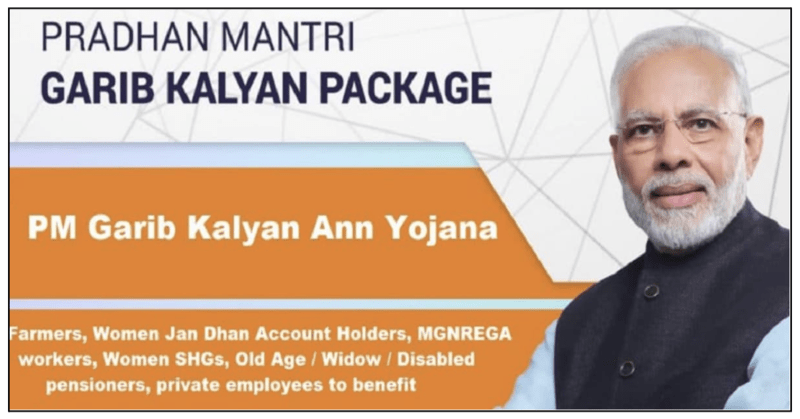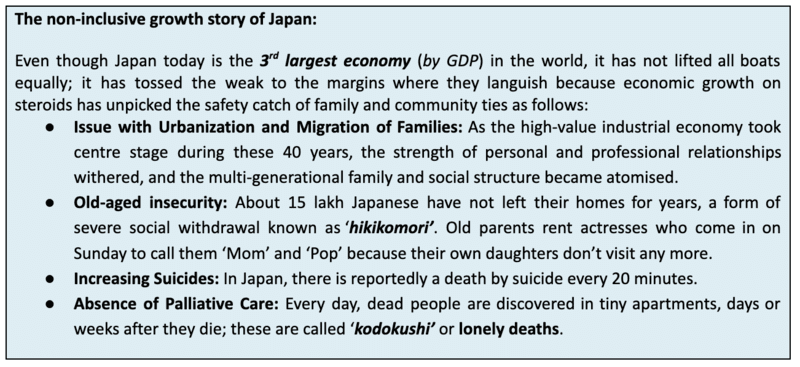A 5 trillion economy, but for whom?
“A nation will not survive morally or economically when so few have so much and so many have so little”. - Bernie Sanders
Relevance: GS I and III (Social Issues and Economy)
- Prelims: Government Initiatives
- Mains: Socio-Economic issues; Challenges for $5 Trillion economy; Government Initiatives;
Why in the News?
Recently, in a Chhattisgarh election rally, PM Narendra Modi announced the extension of the Pradhan Mantri Garib Kalyan Ann Yojana for more than five years till 2028.
- By 2028, the government expects India to become the world’s third-largest economy, with a GDP of $5 trillion.
Now, what is the dilemma presented in context with 2028 goals?
- Statement: The extension of Pradhan Mantri Garib Kalyan Anna Yojna, a scheme that provides 5 kg of free food grains every month to beneficiaries under the National Food Security Act, means that 80 crore Indians will be receiving free food grains to stave off hunger in 2028.
- Derivation: So till 2028, will a large number of the Indian population still remain hungry with a GDP of $5 trillion? Secondly, who will benefit from the five-year extension to these targets?

Current Scenario: Global per capita income 2022:
- India: Per capita income of $2,400. (Ranks 149th among 194 countries)
- Japan: Per capita income of $34,000
- China: Per capita income of $13,000 (still China has outstripped Japan in world GDP rankings)

What are the Challenges for the $5 Trillion economy in India?
- Deep divide: India’s economic growth pivots on capital, productivity and labour, and data show that for over four-fifths of Indians, the $5 trillion economy is a bridge too far.
- According to Oxfam, in 2021, only 1% of the population owned about 41% of the nation’s wealth, and 50% of the population owned 3% of its wealth.
- Lower participation for Economic progress: Citizens with low resources fund the investment; for example., approximately 64% of the total GST comes from the bottom 50% of the population, while the top 10% contribute only 3% of GST.
- Lower skilled Labour force: The contribution of labour, which is considered as the driver of growth, is crippled due to uncertain educational and skill attainments and halting digital literacy.
- Unavailability of opportunity at the grassroots level: The cutting-edge sectors and tools are not native to the 80 crore marginalised citizens.
- Although there are government initiatives like GST, Insolvency and Bankruptcy Code, Make in India, Start-Up India, Production Linked Incentives, yet they cannot seize the opportunities in data science or robotics or Fintech.
Way forward:
- Increasing skilled workforce: Productivity is the primary criteria to get boost through the creation of digital and physical infrastructure.
- Increasing Social security through formal employment: India’s formal sector, is less than 13% today, it has secured only 10% of workforce under ESIC, i.e. 3.39 crore members and only 12% covered under EPFO.
- Hence, the workforce does not get social security benefits like maternity leaves, ESIC, EPFO and other similar social security benefits that are passed by our Union.
- Need for a deeper probe of government policies (socio-economic): Growth in ESIC and EPFO contributions will lead to the better implementation in healthcare, public long-term infrastructure, and beneficial logistics and infrastructure expenditure allows faster investment in manufacturing (both for domestic and exports segments).
- Providing equal opportunity: We need to invest in our people by giving them opportunities that are equal, formal, secure, and social-security backed. It should allow them and their families to aspire and move upwards in life, both currently and in the future.
Mains PYQs
Q. How globalization has led to the reduction of employment in the formal sector of the Indian economy? Is increased informalization detrimental to the development of the country? (UPSC 2016)
Q. What are the salient features of ‘inclusive growth’? Has India been experiencing such a growth process? Analyse and suggest measures for inclusive growth. (UPSC 2017)
Q. Define potential GDP and explain its determinants. What are the factors that have been inhibiting India from realizing its potential GDP? (UPSC 2020)
Prelims PYQs
Q. A decrease in tax to GDP ratio of a country indicates which of the following? (UPSC 2015)
- Slowing economic growth rates
- Less equitable distribution of National Income
Select the correct answer using the codes given below:
(a) 1 only
(b) 2 only
(c) Both 1 and 2
d) Neither 1 nor 2


